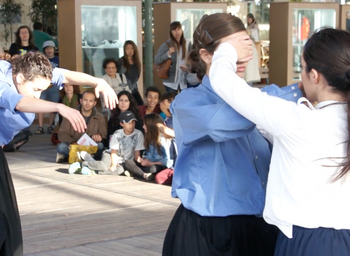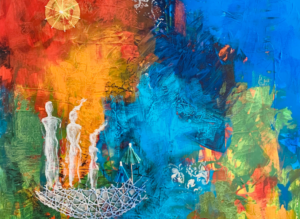Responding to Scripture
(9 min) In the heart of Jerusalem, religious women dance in a public space. In response to an ancient Jewish text, they allow themselves to explore their bodies, to be exposed, and to test their identity beyond space and time.
In the background of the first image of ZOT (refers to this woman), the dancers and passersby begin to hear ancient passages from the Talmud. The words sear the air: “Voice, in a woman, is nakedness”, “Do not converse excessively with women”, “Women are light minded”, “He who teaches his daughter Torah, it is as though he is teaching her foolishness”, “Let Scripture burn lest it be passed on to women”, “And your passion shall be for your husband, and he will rule over you.” The dancers’ bodies are restrained and frightened. They listen to the words and shrink. Suddenly, they feel like they want to examine the space around them and examine their bodies. The audience is a witness to their research. The dancers share their process and allow themselves to be exposed through their physical response to the humiliating text.
“In a magical way, I felt that physical research and dance gave me a safe place to express myself and create a bridge between the traditional text and the woman I am today.” – Efrat Nehama
Choreography: Efrat Nehama
Dancers: Kelly Ayash, Lee Yifrach, Iris Alter
Costume Design: Sarit Sharara
Photographer: Matan Pinks
Efrat Nehama is a choreographer, poet and performing artist who lives and works in Jerusalem.
Reflections
For everyone:
Does a boundary define, limit, paralyze, or motivate you?
For changemakers:
Is there a Jewish text that motivates you to create change?
For dancers:
According to your experience, does dance have the power to release text from the ideas captured in it?
Want more?
Get curated JewishArts.org content in your inbox



